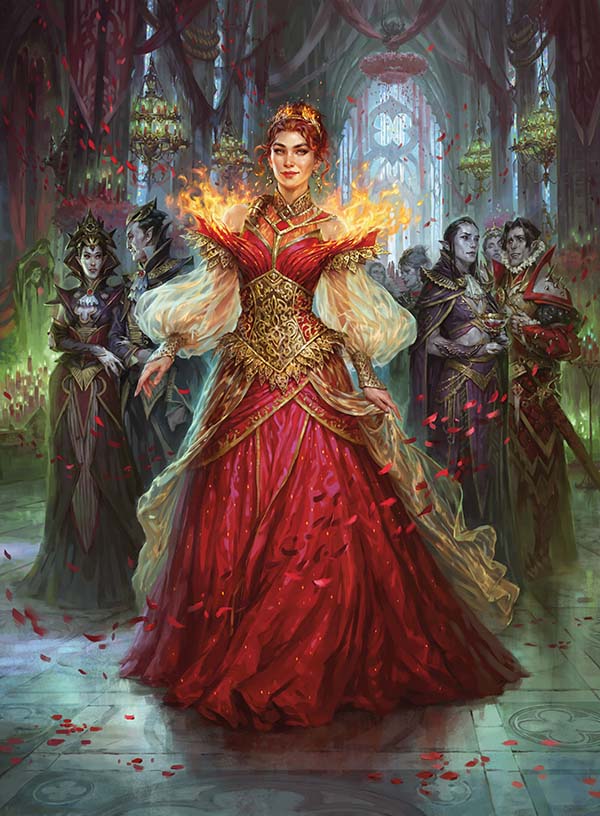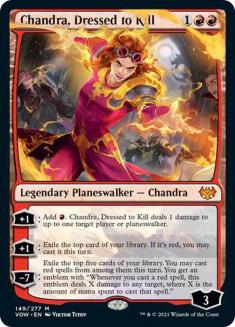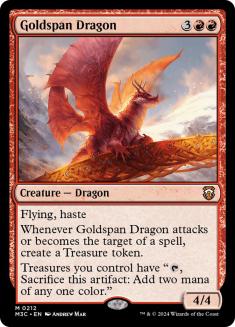We’ve once again entered preview season with Innistrad: Crimson Vow, and unsurprisingly Halloween weekend brought a large number of new cards for us to evaluate. And while this set is entering into an established metagame, we’re early in the life cycle of Standard, so there’s plenty of opportunity for new cards to shake things up and bring life to new decks.
One card that I think is powerful enough to make a significant impact in Standard is Chandra, Dressed to Kill.
Already, the promise of a three-mana planeswalker is intriguing, because the bar for planeswalkers at three mana is much lower than four. This is because planeswalkers are at their best when you can cast them early and start generating incremental advantages as early as possible. Landing them early also makes it less likely that your opponent has developed a battlefield that can immediately threaten to attack it for lethal damage.
I’m also intrigued by the raw stats here, because starting on three loyalty and ticking up means it will survive cards like Cathartic Pyre and Dragon’s Fire. Thundering Rebuke and Demon Bolt are still common right now, but there’s no guarantee that stays the same in the coming months. Removal in Standard is always shifting based on metagame considerations, so dodging any of the most common choices is beneficial.
Looking at the abilities of Chandra gives even more reason to be excited for the card’s prospects in Standard. The first ability reminds me of a powered-down version of Teferi, Hero of Dominaria or Goldspan Dragon. That rebate on the initial cost sets you up to double-spell very early on in the game, provided you have a spell that costs a single red mana. Fortunately there are several quality options that fit that mold in Standard, from Frost Bite to Play with Fire to Spikefield Hazard. Even if your opponent has had a strong start, you can use those removal spells to ensure Chandra will survive.
Beyond the double-spell potential, this ability can also ramp you into powerful five-mana plays. With Volatile Arsonist joining Goldspan Dragon, there’s no shortage of powerful threats to cast ahead of the curve.
Pinging your opponent or one of their planeswalkers is a bit of gravy on top of the mana, but over time that damage can add up, and there will certainly be games where your opponent doesn’t cast a planeswalker because the extra damage means it’s not safe. The main takeaway here is that Chandra is maximized in a more aggressive shell where that damage is most relevant. I’ll be keeping that in mind when building around it.
The second +1 ability is the real meat of the card, offering a steady stream of card advantage that will take over a game if left unchecked. The restriction on only casting red cards reminds me of Domri Rade, which was a staple during its time in Standarddespite only drawing creatures. Obviously Chandra will play best in a mono-red deck, but as long as you have at least 24-26 hits, it will play decently in a two-color shell as well.
What I like most about Chandra is how its +1 abilities play well together. Typically, the second ability would be unnecessary in the early-game because you have plenty of cards still in your hand to cast. Conversely, the first ability becomes less relevant as the game goes on as you have no use for the extra mana. So there’s a natural sequence where you cast Chandra early, use the first ability aggressively to generate a tempo advantage, and then transition to using the second ability to reload so your opponent can’t catch up.
First up is a deck built to maximize Chandra with every choice:
Creatures (20)
- 4 Bloodthirsty Adversary
- 4 Reckless Stormseeker
- 4 Volatile Arsonist
- 4 Manaform Hellkite
- 4 Kessig Wolfrider
Planeswalkers (4)
Lands (20)
Spells (16)
Sideboard

This deck has 40 hits for Chandra’s second ability, about as many as you can play without a very low curve and land count. It has multiple one-mana removal spells in Spikefield Hazard and Play with Fire. Even as the game goes long there are mana sinks in Kessig Wolfrider, Roil Eruption, Den of the Bugbear, and Shatterskull Smashing to take advantage of that mana. It has multiple quality five-mana plays to ramp into because of Bloodthirsty Adversary. And it’s aggressive with plenty of reach, from both burn spells and haste creatures, to make sure the incidental damage Chandra deals is relevant as often as possible.
There’s no place where Chandra is not central to how this list is built, but it’s still coherent without Chandra as a red aggressive deck with a slightly higher curve and plenty of card advantage, which is reminiscent of the days of Chandra, Torch of Defiance and Bomat Courier when red decks were among the best in Standard. I’m worried that this list is a touch short on early-game action, but it’s certainly capable of punishing slow starts.
There’s also plenty of ability to customize this list since Falkenrath Pit Fighter, Moonveil Regent, and Goldspan Dragon are potential replacements for, or supplements to, Kessig Wolfrider, Manaform Hellkite, and Volatile Arsonist. I chose Wolfrider because I think Thalia, Guardian of Thraben’s return to Standard will bring a lot more Spikefield Hazards, so Wolfrider’s second point of toughness should be quite valuable.
For Manaform Hellkite and Volatile Arsonist, it was my favor towards aggression that led to including the new cards. Moonveil Regent offers some additional card advantage, but that’s less relevant with Chandra in the deck, as well as the various mana sinks that ensure you don’t run out of gas in the late-game. And while Goldspan Dragon is an all-star in Standard, Volatile Arsonist reads incredibly well for an aggressive deck, especially one that has an earlier daybound creature so you can cast it on the night side immediately some portion of the time.
That said, this isn’t a traditional aggressive deck, filled with underpowered cards. All this deck’s threats have the potential to make a huge impact on the game, including the one-mana creature, Kessig Wolfrider. In that sense, this deck feels akin to the Gruul Aggro decks featuring Thundermaw Hellkite and Hellrider during the Return to Ravnica era. Notably, that deck used Domri Rade’s card advantage and utility to great effect.
Moving on, I wanted to see how Chandra would work in a burn-heavy shell, since you’re naturally trying to play plenty of one-mana burn spells to cast with your planeswalker:
Creatures (14)
Planeswalkers (4)
Lands (23)
Spells (19)
- 2 Valakut Awakening
- 4 Roil Eruption
- 4 Frost Bite
- 4 Play with Fire
- 1 Light Up the Night
- 4 Reckless Impulse
Sideboard

Bloodthirsty Adversary, Thermo-Alchemist, and Flame Channeler are all great in a shell like this, although I’ve trimmed on Channeler because its card advantage is less necessary with Chandra now in the mix.
Unfortunately we’re a bit short on quality burn spells in Standard, though I’m considering Igneous Inspiration because of how well it plays with Bloodthirsty Adversary. For now I’m content to play with Frost Bite as the second one-mana burn spell, even though it doesn’t go to the face, because I want the snow theme for Faceless Haven; at that point Frost Bite is too good not to play. The snow manabase means you can’t play many double-faced cards so this deck is lighter on mana sinks. Still, with Valakut Awakening and Reckless Impulse supplementing Chandra’s card advantage, you should be able to find your important cards reliably.
To further help remedy the dearth of mana sinks, I’m trying out a singleton Light Up the Night since it now has a quality planeswalker to support the flashback. It can even double as Spikefield Hazard in the early-game, but it’s not efficient enough for me to want to draw multiple copies in a single game.
This deck is still using the mana ability from Chandra relatively well, but without a high-end five-drop it’s not focused on maximizing that aspect of the card. Instead, you’re primarily interested in the extra reach and card advantage to help find the last burn spell or two to finish your opponent off. I suspect you’ll have plenty of games where you cast multiple copies of both Play with Fire and Roil Eruption, leaving your opponent frustrated at your good fortune, but it’s really just the fact that you’ve torn through half your deck to find them.
Next up is my first attempt at a two-color shell for Chandra. I wanted to support her with other cards that play well with lots of cheap spells, since double-spelling on Turn 3 is the most important sequence for her to see competitive play. That of course means moving into Izzet:
Creatures (8)
Planeswalkers (4)
Lands (20)
Spells (28)

Poppet Stitcher is an obvious one here as a way to maximize your cheap spells, though Smoldering Egg generally plays best with three- and four-mana spells so you don’t have to find four or five of the right spells to transform it quickly. That said, once you do transform it, you want cheap spells to maximize its triggered ability.
Normally I’d look to splash black for Sedgemoor Witch over the Stitcher, but with Chandra needing lots of red cards, it’s hard to make the mana work and still play lots of DFCs. Nor do you have room for many black spells, so Stitcher got the nod.
Despite being two colors, this deck has 32 red cards for Chandra, a great number. Between Chandra, Expressive Iteration, and Reckless Impulse, this deck has plenty of card advantage. Lier tops the curve as a great finisher, especially when you can ramp into it. Overall, Chandra acts similarly in this deck as it does in the Burn deck, but with less emphasis on the reach since this deck is more capable of taking full control over the battlefield as the game goes long. Both decks are using Chandra to assemble a critical mass of cheap removal to back up its threats; it’s just that Burn is aiming them upstairs, while this list is using them to kill opposing threats.
With that late-game power, you can afford to play more flexible removal in Abrade and Thundering Rebuke instead of spells that go upstairs. You still have Spikefield Hazard and Play with Fire to handle early creatures, and with so much card selection it’s important to have flexible answers that you can dig for in specific situations.
Last up is a list that’s trying to maximize the mana generation from Chandra, so not only does it include multiple one-mana burn spells, it also has plenty of big red creatures to ramp into. And when it comes to red and big creatures, you know that means Dragons:
Creatures (15)
Planeswalkers (4)
Lands (21)
Spells (20)
Sideboard

Between Orb of Dragonkind; Magda, Brazen Outlaw; and Chandra, Dressed to Kill, this deck has twelve ramp spells, but importantly, all of them have other functionality. That’s important for a deck like this that isn’t ramping into a game-ending threat, but just trying to get its Dragons down early. If you had straight ramp spells, you’d flood way too often.
With those hard-hitting Dragons doing the heavy lifting towards actually killing your opponent, you don’t need much direct damage, so Frost Bite and Dragon’s Fire are the most appropriate removal spells here. A higher curve means you can still fit Faceless Haven into the deck even with Spikefield Hazard and Shatterskull Smashing. The latter is particularly important for maximizing the mana generation from Chandra.
Inferno of the Star Mounts serves as another mana sink and a great top-end threat that reduces your vulnerability to counterspells, particularly Disdainful Stroke. Counters are a natural response to ramp decks, so having some built-in protection there is valuable.
Chandra is the ultimate bridge threat here to get you from your cheap removal and ramp spells in the early-game to your powerful Dragons as quickly as possible. Once you land a Dragon, your opponent is caught in a tough position where they have to answer the creature quickly or risk dying, but Chandra can sit back and accrue a bunch of card advantage if left unanswered. Ramp decks often have trouble recovering when their first threat or two are answered, so that card advantage makes this deck much harder to plan against.
With so many aspects to the card, there are a ton of shells that can use Chandra, Dressed to Kill effectively. Izzet Dragons or Izzet Epiphany could work, though I’ve focused more on red-heavy decks to maximize the chance of drawing cards. But even if you have one aspect of the card that you’re focusing on most, you should still look to utilize others effectively. Versatility is very important in Magic these days, especially in Standard, and Chandra scores highly on that metric. A card with that kind of versatility at only three mana is an exciting addition to a Standard format that has grown rather stale over the last few weeks. Let’s hope we get several more cards that fit that mold before preview season is over.





